CZ 75
The CZ 75 is a semi-automatic pistol made by Czech firearm manufacturer ČZUB. First introduced in 1975, it is one of the original "wonder nines" and features a staggered-column magazine, all-steel construction, and a hammer forged barrel. It is widely distributed throughout the world and is the most common handgun in the Czech Republic.
| CZ 75 | |
|---|---|
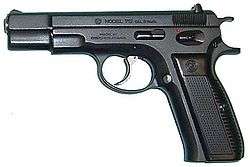 "Pre-B" version of the CZ 75 | |
| Type |
|
| Place of origin | |
| Service history | |
| In service | 1976–present |
| Used by | See Users |
| Production history | |
| Designer | Josef and František Koucký |
| Designed | 1975 |
| Manufacturer | Česká zbrojovka |
| Produced | 1976–present |
| No. built | 1,000,000+ (October 12, 2007)[1] |
| Variants | see Variants and Derivatives |
| Specifications | |
| Mass | 1.12 kg (2.5 lb) |
| Length | 206.3 mm (8.12 in) |
| Barrel length | 120 mm (4.7 in) |
| Width | 32.6 mm (1.28 in) |
| Height | 138 mm (5.4 in) |
| Cartridge | |
| Action | short recoil, tilting barrel, double/single |
| Rate of fire |
|
| Effective firing range | 25 m (for 9 mm CZ-75 family and CZ-75 automatic) |
| Feed system | detachable box magazine, 10–26 rds depending on version and caliber |
| Sights | Front blade, rear square notch |
| CZ P-01 | |
|---|---|
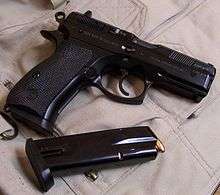 The CZ P-01 | |
| Type | Semi-automatic / fully automatic pistol |
| Place of origin | Czech Republic |
| Service history | |
| Used by | Czech police |
| Production history | |
| Designed | 1999 |
| Manufacturer | Česká zbrojovka |
| Produced | 2001–present |
| No. built | ? |
| Specifications | |
| Mass | 0.77 kg (1.7 lb) with empty magazine |
| Length | 184 mm (7.2 in) |
| Barrel length | 98.5 mm (3.88 in) |
| Width | 35 mm (1.4 in) |
| Height | 128 mm (5.0 in) |
| Caliber | 9×19mm Parabellum |
| Action | short recoil, tilting barrel |
| Rate of fire | semi-automatic |
| Feed system | detachable box magazine |
| Sights | Front blade, rear square notch |
History
Development of CZ 75
The armament industry was an important part of the interwar Czechoslovak economy and made up a large part of the country's exports (see, for example, Bren light machine gun, which was a modified version of the Czechoslovak ZB vz. 26). However following the 1948 communist coup d'état, all heavy industry was nationalized and was (at least officially) cut off from its Western export market behind the Iron Curtain. While most other Warsaw Pact countries became dependent on armaments imports from the Soviet Union, most of the Czechoslovak weaponry remained domestic (for example, the Czechoslovak army used the Vz. 58 assault rifle, while other communist bloc countries used variants of the AK-47).
Following the Second World War, brothers Josef and František Koucký became the most important engineers of the CZUB. They participated to some extent on designing all the company's post-war weapons. Kouckýs signed their designs together, using only the surname, making it impossible to determine which one of them developed particular ideas.[2]
By 1969, František Koucký was freshly retired, however the company offered him a job on designing a new 9×19mm Parabellum pistol. Unlike during his previous work, this time he had a complete freedom in designing the whole gun from scratch. The design he developed was in many ways new and innovative (see Design details).[2]
Although the model was developed for export purposes (the standard pistol cartridge of the Czechoslovak armed forces was the Soviet 7.62×25mm Tokarev, which was later replaced with the Warsaw Pact standard 9mm Makarov pistol cartridge), Koucký's domestic patents regarding the design were classified as "secret patents". Effectively, nobody could learn about their existence, but also nobody could register the same design in Czechoslovakia. At the same time Koucký as well as the company were prohibited from filing for patent protection abroad. Consequently, a large number of other manufacturers began offering pistols based on CZ 75 design (see Clones, copies, and variants by other manufacturers).[2]
The pistol was not sold in Czechoslovakia until 1985, when it became popular among sport shooters (sport shooting is the third most widespread sport in the Czech Republic, after football and ice hockey[3]). It was adopted by the Czech armed forces only after the Velvet Revolution in 1989.[2]
Development of sport variants of CZ 75
The increasing popularity of the IPSC competitions in the Czech Republic led to inception of CZUB's factory team in 1992. Initially, the sport shooters were using CZ 75s and CZ 85s. Stanislav Křižík designed a new version called CZ 75 Champion already in 1992. This version had a SA trigger, a muzzle brake and adjustable weights. 150 firearms were initially made in 9×19mm Parabellum, .40 S&W and 9×21mm. The design was further modified (i.e. the adjustable weights were eliminated, a new compensator was developed), however its main shortcoming of the same capacity as the standard CZ 75 magazines (15/16 in 9mm, 12 in .40 S&W) remained.[4]
The CZ 75 ST (Standard) and CZ 75 M (Modified) were introduced in 1998. These had a different frame from standard versions allowing for more modifications. While the ST had become very successful, M was not initially designed for use with red-dot sights, the use of which led to limited lifespan of its frame.[4]
The popular ST version was further developed mostly with aim of prolonging its lifespan, which led to introduction of CZ 75 TS (Tactical Sports) in 2005. It uses a longer barrel (132 mm) and has also a higher weight (1,285 g) compared to the standard model. High-capacity magazines may use either 20 of the 9mm rounds or 17 of the .40 rounds. As of 2013, the model is used by the CZUB's factory shooters in the IPSC Standard division, with a custom-made version CZ 75 Tactical Sports Open being also available.[4]
In 2009, the sale of CZ 75 TS Czechmate began. The model is a development of the CZ 75 TS Open, available in 9×19mm Parabellum and 9×21mm with magazine capacity of 20 or 26 rounds. As standard, the gun is sold with US made C-More Systems' red-dot sight. CZUB claims that its factory shooter Martin Kameníček had shot 150,000 rounds through the gun in five years, in which time he only needed to change the barrel once in order to maintain precision.[4]
Design details
The CZ 75 is a short recoil operated, locked breech pistol. It uses the Browning linkless cam locking system similar to that used in the Browning Hi-Power pistol, where the barrel and slide are locked together on firing, using locking lugs milled into the barrel mating with recesses in the roof of the slide. An enclosed cam track integral with the barrel is actuated by the slide release lever's transverse pin. After the first few millimetres of the recoil stroke, the barrel is cammed downwards at the rear, enabling the slide to continue the recoil stroke and eject the spent cartridge.
Most models have the capability of being fired in both single and double-action modes, and feature a frame-mounted manual safety. Some recent models have a decocking lever that doubles as a manual safety. Starting in the early 1990s, all CZ 75s have been made with firing pin blocks, designated by the letter B (as in CZ 75B).
The CZ 75 was one of the first high-capacity 9mm pistols with a manual safety similar to that of the Browning Hi-Power. This allows the CZ 75 to be carried with the hammer cocked with safety applied and a round chambered, ready for use simply by switching the safety off, a configuration known as condition 1. It is somewhat unusual for double-action pistols to have this "cocked and locked" type of safety; most such as the Walther P38 and the Beretta 92F have a combination safety/decocking lever (as do some later versions of the CZ 75). The trade-off of this configuration is that to uncock the hammer for a double-action first shot, the hammer must be dropped manually by pulling the trigger while lowering the hammer with the firer's thumb under control. Once lowered in this manner, a double-action first shot can be achieved in a similar manner to other double-action pistols without actuating any controls. Subsequent shots will be single-action unless the hammer is again manually lowered.
All non-double-action only CZ-75 variants feature a "half-cock" notch. This is not a safety position, but rather an operator aid to provide a safe place to manually decock the pistol. All of the "decocker" models decock to this position, and the manual advises not to attempt to place the hammer further on any model.
Unlike most other semi-auto pistols, the slide rides inside the frame rails, similar to the SIG P210, rather than outside. This provides a tight slide-to-frame fit and a very efficient barrel lock-up, both of which contribute to its accuracy.
On current models, frames are cast and slides are machined from forgings, though forged frames have been used in very early production models. The six-groove barrel has traditional land-and-groove rifling with a higher-than-standard rate of twist (1 in 9.7).
Variants and derivatives
CZ variants of the CZ 75 include:
75 Steel Full Size
- CZ 75
- The original CZ 75, easily identified by the heavily stepped slide and short slide rails
- CZ 75
- Late version, easily identified by longer slide rails and shorter slide-step
- CZ 75 B
- Second-generation CZ 75, upgraded with an internal firing pin safety, squared and serrated trigger guard, and ring hammer
- CZ 75 BD
- A variant of the now-common CZ 75 B (B standing for firing pin block) with a decocker replacing the traditional manual safety. (D stands for decocker.) This variant is quickly becoming the most common of the CZ 75B models, due to the additional safety the decocker safety provides.
- CZ 75 BD Police
- Variant of the CZ 75 BD equipped with loaded chamber indicator, reversible magazine catch, lanyard ring, checkered front and back strap of the grip and serrated trigger as standard. Most Police models have "Police" stamped on the slide. A smaller amount exclude "Police" but have front slide serrations.
- CZ 75 B Stainless
- Stainless steel version of the CZ 75 B. Available in a high gloss and matte stainless finish. Also available in the new/limited edition (sand blasted finish with sides of the slide and frame decoratively ground). All stainless models feature ambidextrous safeties.
- CZ 75 B Omega (2009-2015)
- A version of the CZ 75 B with a factory-reworked trigger group, the "Omega" system, introduced with the P-07. It is available chambered for 9 mm or .40 S&W. It has a manual safety that is not ambidextrous.
- CZ 75 B Omega Convertible (2016-)
- An updated version of the previous CZ 75 B Omega. It comes with a decocker that can be easily swapped to a manual safety, with the included kit. The decocker or the safety are ambidextrous. It also has the hammer and the sights updated.
- CZ 75 B SA (cancelled 2018)
- A CZ 75 which has a single-action trigger mechanism and a drop-free magazine. It is available chambered for 9 mm or .40 S&W.
- CZ 75 B DAO (cancelled)
- A CZ 75 that has a longer and heavier, constant trigger pull (double-action only). Chambered for 9mm and .40 S&W. Featuring no external safety or decocker as well as a bobbed hammer.
75 Compact
- CZ 75 Compact
- A standard CZ 75 with a slightly shortened grip and 3.9-inch barrel. There is a version available chambered for the .40 S&W.
- CZ 75 D PČR Compact
- Very compact – similar to the P-01 in size, with an aluminum alloy frame also but lacks an M3 rail frame and features a smaller muzzle point and snag free sights. A popular choice for a carry weapon, known for its inherent accuracy and weight distribution.
- CZ 75 SemiCompact
- Combines the frame, grip and capacity of the full size CZ 75 with the shortened (by 20mm) barrel and slide of the CZ 75 Compact.
- CZ P-01
- A CZ 75 Compact variant intended for law enforcement use, with an aluminum alloy frame, decocker and under-barrel accessory rail. It is the new weapon of choice for the Czech National Police since 2001. It received NATO certification after undergoing extensive testing. Its NATO Stock Number (NSN) is 1005-16-000-8619.[5]
- CZ P-01 Omega Convertible
- A version of the CZ P-01 with the new Omega trigger system. It comes with a decocker that can be easily swapped to a manual safety, with the included kit. The decocker or the safety are ambidextrous. It also has the hammer and the sights updated.
- CZ P-06
- Same as the P-01 but in .40 S&W
- CZ 40-B/Colt Z-40
- Collaboration between Colt/CZ. 1911 style frame made by Colt to use a CZ style slide chambered in .40 S&W. Was the basis of design for the RAMI 2075 series.
- CZ 40-P
- After the CZ-40B/Colt Z-40 project fell apart CZ used the left over slides and fit them to P-01 frames and sold as the CZ 40-P in .40 S&W. A small amount of CZ 40-P guns still have the CZ 40-B roll marks.
Sub Compact
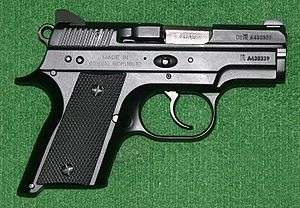
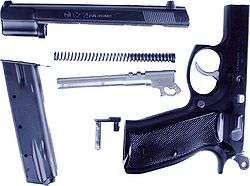
- CZ 2075 RAMI
- A subcompact version of the CZ 75 intended for concealed carry. Features a 3-inch barrel, aluminum frame and low-profile sights. Available in 9×19mm or .40 S&W, with standard magazine capacities of 10 (9×19mm) and 8 (.40 S&W) rounds, respectively. An optional 14-round magazine is available for the 9 mm version.
- CZ 2075 RAMI BD
- Same as the 2075 RAMI but includes a decocker and tritium sights
- CZ 2075 RAMI P
- Polymer framed version
Competition
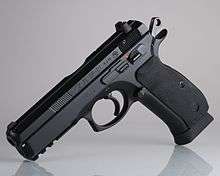
- CZ 75 SP-01/SP-01 Tactical
- Similar to the P-01 with accessory rail, but with all-steel construction and utilizing the full-size frame and slide as well as incorporating extended-capacity 18-round magazines. It is available with an ambidextrous manual safety (SP-01) or with an ambidextrous decocker (SP-01 Tactical). The CZ 75 (SP-01) was designed for multiple purposes including but not limited to: a military/law enforcement duty sidearm, sidearm for counter-terrorism forces, and field/target shooting.[6] Used in the 2005 IPSC World Shoot XIV by World Champions Adam Tyc and Angus Hobdell (1st and 3rd place respectively in the production division).[7]
- CZ 75 SP-01 Shadow
- New generation of CZ 75 SP-01 pistol especially adapted according to suggestions as proposed by users from communities worldwide, with an additional input from the Team CZ shooters Angus Hobdell and Adam Tyc. Based on the SP-01, it has no firing pin block resulting in improved trigger travel. It also features a slightly reshaped grip and safety, a “weaker” recoil spring for easier loading, and fiber optic front sight and tactical “Novak style” rear sight.[8]
- CZ 75 Shadow 2
- In 2016, with the cooperation of the elite IPSC shooters of the Česká zbrojovka team, an improved version of the Shadow was released, called the Shadow 2. It included a longer barrel, a reshaped, lighter-weight slide, more aggressive slide serrations, improved grip ergonomics, aggressive grip checkering, and a smaller fiber optic in the front sight.
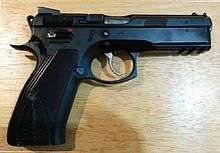
- CZ 75 SP-01 Phantom
- The CZ 75 Phantom has a polymer frame, is 33% lighter than steel frame models, with accessory rail and a forged steel slide with a weight saving scalloped profile. Two Interchangeable grip rear strap inserts are included with the Phantom to accommodate users with different sized hands. The pistol is further outfitted with a decocking lever. Czech Army Paratroopers of the 4th Rapid Deployment Brigade are fully equipped with this pistol from January 2012.
- CZ 75 Standard IPSC
- A CZ 75 variant designed specifically for IPSC competition with extended grip, single-action trigger, heavy-duty free-falling magazines, and an enlarged magazine well.
- CZ 75 Tactical Sports
- Replacing the ST IPSC was the tactical sports model, which featured minor improvements over its very similar predecessor. Available in 9×19mm (20 rounds) or .40 S&W (17 rounds).
- CZ 75 Champion
- A competition version designed for Open Division IPSC competition, with three port compensator, adjustable trigger, extended magazine release, ambidextrous safeties, fully adjustable sights and two-tone finish, with blued slide and satin nickel frame.
- CZ 75 TS Czechmate
- A competition variant based on the Tactical Sports model, equipped with a compensator and electronic red-dot sight on a frame mount. Designed especially for IPSC Open Division (and replacing the older Champion model), the Czechmate presents a turnkey solution for the sport, offering a complete competitive package including additional magazines and spare parts.
- CZ 75 Kadet/Kadet 2
- A .22 LR caliber slide/ barrel assembly and magazine kit to fit onto most standard CZ 75B frames (except the Tactical Sport and SP-01 Phantom). The Kadet also used to be sold as a complete pistol (slide assembly and frame), but is now only sold as a slide assembly to be mounted on existing frames. The 2nd generation conversion kit currently being sold is called the "Kadet 2", and includes a dedicated .22 slide stop that locks the slide back on an empty magazine. Night sights are optional.
Polymer
- CZ P-07 Duty
- The CZ P-07 Duty is a compact, polymer-framed CZ 75 variant notable for having a redesigned trigger mechanism. The redesign has reduced the number of parts as well as improved the trigger pull. The exterior restyling was greatly influenced by the SPHINX 3000 design (itself being an enhanced Swiss CZ 75 clone). Chambered in 9mm Luger and .40 S&W, the CZ P-07 DUTY also includes the ability to change the manual safety to a decocking lever and vice versa through an exchange of parts. Introduced in 2009.
- CZ P-09 Duty
- Full-size version of the P-07, boasting 19 round capacity in 9mm. Introduced in 2013.
- CZ P-09 Kadet
- A .22 LR caliber slide/barrel assembly and magazine kit to fit onto standard CZ P-09 frames, similar to the CZ 75 Kadet/Kadet 2. The Kadet is sold as a complete pistol (slide assembly with frame) or a standalone slide assembly to be mounted on existing frames, and can be used as a training gun for the standard P-09. The frame is made from mechanically and thermally stable polymer reinforced with glass fibre, equipped with an underside MIL-STD-1913 rail for accessories. The slide has two pairs of cocking grooves for comfortable handling, and adjustable iron sights. The gun has easy-to-change manual safety and decocking controls, with three interchangeable grip backstraps in small, medium and large sizes.
85
- CZ 85
- An updated version of the CZ 75 that is also ambidextrous
- CZ 85B
- A CZ 85 with a firing pin block
- CZ 85BD
- A CZ 85 B with a decocking lever, instead of a safety
- CZ 85 Compact
- A limited production compact CZ 85 with under-barrel accessory rail and chambered in .40 S&W. Identical to the current CZ 75 compact in .40 S&W.
- CZ 85 Combat
- adds an adjustable rear sight, extended magazine release, drop-free magazine and overtravel adjustment on the trigger. Lacks a firing pin safety so that firing pins can be replaced without special fitting.
97 (.45 ACP)
- CZ 97B
- .45 ACP version of the CZ 75 B
- CZ 97 BD
- .45 ACP version of the CZ 75 BD
Others
- CZ 75 Automatic
- A selective-fire variant introduced in 1992 intended for law enforcement and military use. One distinguishing characteristic of earlier models is its longer compensated barrel although later models may have a standard barrel. An extra magazine can be attached to the front to act as a makeshift foregrip.
Clones, copies, and variants by other manufacturers
Today the CZ factory is located in the Czech Republic (EU) and the handgun is offered worldwide. However, during the Cold War, Czechoslovakia was part of the Warsaw Pact and thoroughly communist in its political outlook. The CZ 75 was the first 9mm semi-auto pistol developed expressly for sale to the West and it offered new ideas in auto-pistol manual safety design, being a dual mode design. It could be carried in the conventional double-action/single-action mode of operation, or it could be carried "cocked and locked" like the 1911 pistol.[9]
Due to a 60 percent duty on Czech-made products at the time and because CZ failed to secure world patent protection for their design, CZ could not market their pistol in the United States when it debuted. Instead, the Italian firm Fratelli Tanfoglio made and marketed the pistol to the West.
Two shooters, American Doug Koenig and Frenchman Eric Grauffel, won the IPSC World Championship using pistols based on the CZ 75 design (all other World Champions up to the time had used pistols based on the John Browning 1911 format).[9] Other notable copies/clones are those of Sphinx Systems.[10]
The clones, copies and variants by other manufacturers include:




















Users
- Many countries use copies and clones produced by local manufacturers (see above). This incomplete list only includes users of the original Czech-made CZ 75 and its variations.











.svg.png)
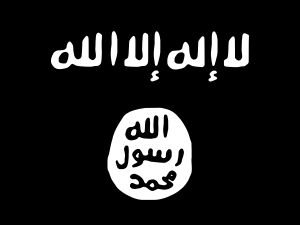

















See also
- CZ 97B, a similar weapon by the same company chambered for the .45 ACP cartridge
- NZ 85B
- List of firearms
References
- "THE CZ 75 PISTOL MODEL PASSED ONE MILLION PIECES" (Press release). 2007-10-22. Archived from the original on 2008-06-30.
- "Zašlapané projekty Pistole CZ 75". Česká televize (in Czech). Retrieved 2011-02-23.
- Kyša, Leoš (January 28, 2011). "Počet legálně držených zbraní v Česku stoupá. Už jich je přes 700 tisíc" (in Czech). ihned.cz. Retrieved January 28, 2011.
- Kučera, Pavel (2013), "CZ 75 TS Czechmate Parrot", Zbraně & náboje (5): 10–15
- "CZUSA CZ P-01 gets NATO approval" (Press release). 2003-02-01. Archived from the original on 2009-02-17.
- "CZ 75 SP-01 Tactical - CZ-USA".
- "CZ 75 SP01 9mm, light rail, safety, black polycoat 91152". Czcustom.com. Archived from the original on 16 March 2010. Retrieved 9 December 2014.
- "CZ 75 SP01 SHADOW 9mm 91154 Black CZ Custom Exclusive". Czcustom.com. Archived from the original on 14 December 2014. Retrieved 9 December 2014.
- James, Frank (2004). Frank James: Effective handgun defence. Iola, WI: Krause Publications.
- "Gun Review: Sphinx 3000: "Built like a fine Swiss watch"". Guns.com. Archived from the original on 9 December 2014. Retrieved 9 December 2014.
- "The CZ-75 and Its Early Clones". gundigest.com. Retrieved 2011-02-23.
- "Modern handguns – CZ 75 pistol (Czech Republic)". World guns. Retrieved 2011-03-01.
- A Czech emigrant Ing. Tůma was among first to start manufacturing direct copies of CZ 75. Soon he developed own variant of the pistol, which he later offered to Swiss company Sphinx. Sphinx continues to manufacture its own variants of CZ 75 up today. See Zašlapané projekty Pistole CZ 75 (Czech)
- "EAA Witness". shootingillustrated.com. Archived from the original on 2016-03-04. Retrieved 2011-04-25.
- "General and complete disarmament: transparency in armaments". United Nations. Retrieved 2020-08-06.
- "Gun Review: CZ P-09 Duty". The Truth About Guns. Retrieved 2014-01-02.
- "Ruční zbraně AČR" (PDF). Army.cz. Retrieved 9 December 2014.
- "Naše pistole střílela, i když ji Egypťané máčeli v blátě, říká manažer České zbrojovky". ihned.cz. Retrieved 2013-05-04.
- Montes, Julio A. (May 2000). "Infantry Weapons of the Salvadoran Forces". Small Arms Review. Vol. 3 no. 8.
- "Toulouse. Le nouveau stand de tir de la Police municipale fait un vrai carton".
- "Georgian Army". Georgian Army. Archived from the original on 2012-03-09. Retrieved 2007-06-25.
- "Police Small Arms Arsenals in the Northern Central American Triangle". Small Arms Defense Journal. Vol. 7 no. 5. 4 December 2015.
- M. Ahsan Jamal. "ISIS Weapons and Ammunitions". International Relations Insights & Analysis. Retrieved 2018-09-27.
- Постановление Правительства Республики Казахстан № 744 от 5 августа 1998 года "О разрешении Министерству внутренних дел Республики Казахстан ввоза оружия с боеприпасами и принадлежностями из Чешской Республики"
- Kazakhstan Special Forces (1/3) on YouTube
- Kazakhstan Special Forces (2/3) on YouTube
- Jenzen-Jones, N.R.; McCollum, Ian (April 2017). Small Arms Survey (ed.). Web Trafficking: Analysing the Online Trade of Small Arms and Light Weapons in Libya (PDF). Working Paper No. 26. p. 67.CS1 maint: ref=harv (link)
- "Česká zbrojovka dodá mexické policii zbraně za 180 milionů". Aktuálně.cz – Víte co se právě děje. Retrieved 9 December 2014.
- JSK Internet. "Z czego strzela Policja? (nr 51 06.2009)". Policja 997. Retrieved 9 December 2014.
- "Lenta.ru: Наука и техника: Прокуроров и следователей вооружат новыми пистолетами". Lenta.ru. Retrieved 9 December 2014.
- "Specijalne-jedinice.com - CZ-75 SP-01 Shadow". specijalne-jedinice.com.
- http://specijalne-jedinice.com/img/dummies/CZ75SP01/13.jpg
- Tuoi Tre Newspaper. "Police to expand investigation into smuggled guns detected at Vietnam airport". tuoitrenews.vn.
- "Týmito zbraňami nás polícia chráni". pluska.sk (in Slovak). Retrieved 2011-03-01.
- https://web.archive.org/web/20081227234250/http://www.mic.sd/images/products/wepons/en/pisazhri.htm
- https://web.archive.org/web/20081227234256/http://www.mic.sd/images/products/wepons/en/pissewar.htm
- "รายชื่ออาวุธยุทโธปกรณ์ในกองทัพอาเซียน". Thaiarmedforce.com. Archived from the original on 28 May 2013. Retrieved 9 December 2014.
- Fred J. Pushies: Weapons of Delta Force, Zenith Imprint, 2010, page 53
Bibliography
- Ramos, J.M. CZ-75 Family: The Ultimate Handgun. Boulder, Colorado, USA: Paladin Press, 1990. ISBN 0-87364-566-9.
External links
| Wikimedia Commons has media related to CZ-75. |